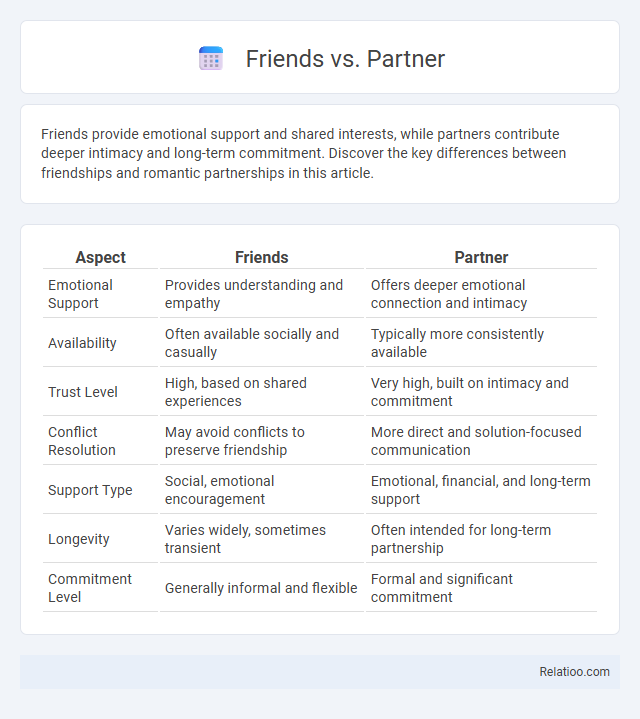Friends provide emotional support and shared interests, while partners contribute deeper intimacy and long-term commitment. Discover the key differences between friendships and romantic partnerships in this article.
Table of Comparison
| Aspect | Friends | Partner |
|---|---|---|
| Emotional Support | Provides understanding and empathy | Offers deeper emotional connection and intimacy |
| Availability | Often available socially and casually | Typically more consistently available |
| Trust Level | High, based on shared experiences | Very high, built on intimacy and commitment |
| Conflict Resolution | May avoid conflicts to preserve friendship | More direct and solution-focused communication |
| Support Type | Social, emotional encouragement | Emotional, financial, and long-term support |
| Longevity | Varies widely, sometimes transient | Often intended for long-term partnership |
| Commitment Level | Generally informal and flexible | Formal and significant commitment |
Defining Friendship and Romantic Partnerships
Defining friendship involves mutual trust, shared interests, and emotional support without romantic expectations, while romantic partnerships prioritize intimacy, commitment, and physical connection. Your friends provide companionship and a safe space to express yourself, fostering long-term loyalty and understanding. Differentiating these relationships helps clarify boundaries and deepens the quality of connections in both social and romantic contexts.
Emotional Support: Friends vs Partners
Friends provide significant emotional support through shared experiences, empathy, and a non-judgmental presence that fosters mental well-being. Partners often deliver deeper emotional intimacy, consistent encouragement, and personalized understanding rooted in romantic commitment, enhancing resilience during stressful periods. Both relationships contribute uniquely to emotional stability, with partners typically offering sustained support and friends providing diverse perspectives and social connection.
Communication Styles in Friendships and Relationships
Effective communication styles significantly impact Friends, Partners, and Friend dynamics by shaping trust and understanding. Your ability to adapt communication--using active listening, empathy, and clear expression--can strengthen emotional bonds in friendships and romantic relationships alike. Recognizing differences in verbal and nonverbal cues between Friends and Partners enables healthier conflict resolution and deeper connection.
Boundaries: Navigating Personal Space
Friends, partners, and friends-with-benefits each require distinct boundaries to maintain healthy interactions; friends often share mutual respect for personal space without emotional intimacy, while partners navigate deeper emotional and physical boundaries tied to commitment. Clear communication about limits and expectations helps prevent misunderstandings and fosters trust in all relationships. Recognizing and respecting these boundaries supports individual autonomy and strengthens the quality of connections.
Trust and Loyalty Compared
Trust and loyalty form the foundation in relationships with friends, partners, and casual friends, yet their depth and expectations vary significantly. Partners typically demand higher levels of mutual trust and unwavering loyalty due to emotional intimacy and shared life commitments. Friendships maintain trust and loyalty through consistent support and honesty, while casual friends often have limited expectations in these areas.
Conflict Resolution: Friends versus Lovers
Friends often resolve conflicts through open communication, mutual understanding, and a shared history that fosters patience and forgiveness. Partners or lovers tend to face conflicts with greater emotional intensity, requiring strong empathy, compromise, and the ability to navigate complex feelings to maintain intimacy. While friends may prioritize harmony and long-term trust, couples must balance individual needs with collective goals to sustain their relationship.
Shared Interests and Activities
Shared interests and activities often define the dynamics between friends and partners, with friends typically bonding over hobbies, mutual passions, or social events that foster a relaxed and enjoyable connection. Partners engage in shared activities that deepen emotional intimacy, such as planning future goals, supporting each other's personal growth, and navigating life challenges together. Your ability to nurture these relationships depends on recognizing how shared experiences build trust and understanding in both friendships and partnerships.
The Role of Intimacy
The role of intimacy varies significantly between friends, partners, and friend-partners, shaping the depth of emotional connection and trust. Friends typically share a supportive bond characterized by companionship and shared interests, while partners engage in a deeper level of intimacy involving physical closeness, emotional vulnerability, and long-term commitment. Your understanding of intimacy influences how you navigate these relationships, balancing emotional openness with the expectations unique to each connection.
Life Stages: Evolving Dynamics
Your relationships with friends and partners evolve significantly across different life stages, reflecting changing priorities and emotional needs. During early adulthood, friendships often center around shared experiences and social exploration, while partnerships deepen through commitment and shared goals. As life progresses, shifting responsibilities such as career, family, and personal growth transform these dynamics, requiring adaptability and renewed communication to maintain balance.
Balancing Friendships and Romantic Relationships
Balancing friendships and romantic relationships requires clear communication and setting healthy boundaries to ensure both connections thrive. Your partner needs emotional support and quality time, while friends provide social balance and personal growth opportunities. Prioritizing your time and openly discussing expectations can prevent conflicts and strengthen both friendships and your romantic bond.

Infographic: Friends vs Partner
 relatioo.com
relatioo.com